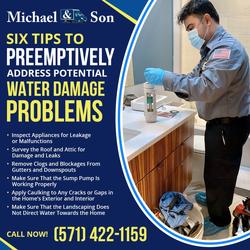Six Spring Cleaning Tips to Help Homeowners Prevent Water Damage
As warm weather and sunny days herald the arrival of spring and summer, the last thing that homeowners want to think about is water damage repair. However, during the season of spring cleaning, homeowners have the opportunity to address potential issues that could lead to water damage in their homes.
According to water damage statistics compiled by IPropertyManagement.com, 14,000 Americans per day are faced with a water damage disaster. If homeowners can prevent water damage before it occurs, they can avoid an expensive and stressful water damage disaster in the future. Michael & Son Water and Mold, a water damage restoration company Serving Fredericksburg is sharing six tips that people can add to their spring cleaning checklist in order to preemptively address potential water damage problems.
Tip #1: Inspect Appliances for Leakage or Malfunctions
Leaking appliances are a leading cause of water damage in residential settings. Dishwashers, refrigerators, and washing machines are water damage disasters waiting to happen, so it is essential to regularly inspect these appliances to ensure that they are functioning correctly and have not been damaged. Follow the checklist below:
- Look for signs of small leaks that might usually go unnoticed
- Review the appliance manual to make sure the appliance is operating properly
- Replace defective, cracked, or torn seals
- Inspect all supply hoses
- Make sure all valve connections are tight
- Look into acquiring a leak detector
- Inspect the dishwasher door gaskets
- Consider upgrading to stainless steel cord instead of plastic supply tubing for water supply tubes to the washing machine
Tip #2: Survey the Roof and Attic for Damage and Leaks
Roof leaks are another top cause of water leaks. A leaking roof allows water intrusion to damage the ceiling, attic, and walls, causing wooden building materials to rot and mold growth to take hold.
The homeowner does not have to climb onto the roof to conduct an inspection. A camera, smartphone, binoculars, or even a drone can give the homeowner an adequate view of the roof’s condition. Also, if the home has an attic, look for any signs or smells of water damage or microbial growth.
Family Handyman, an online resource for DIY and home improvement projects, provides the following recommendation: “Look for missing shingles, metal pipes that are damaged or missing or anything that simply doesn’t look right. If you notice anything that needs closer inspection or repair, call a roofer.”
Tip #3: Remove Clogs and Blockages From Gutters and Downspouts
Gutters and downspouts help guide water away from the foundation of a house, preventing water from entering the structure or compromising the foundation. When these fixtures become clogged, the water build-up can rot away the wooden exterior near the eaves and create new avenues for water to seep into the home.
Use a ladder to reach the gutters but be careful not to damage them. Remove leaves, moss, debris, mildew, mold, or any other obstructions, then use a garden hose to flush the fixtures with water. Never use a pressure washer to clean gutters and downspouts since the high pressure and heat of this cleaning method can cause damage.
Tip #4: Make Sure That the Sump Pump Is Working Properly
Homes that have a basement often have a sump pump that automatically extracts water should the basement flood. Yearly testing and cleaning helps ensure that the sump pump is in good working order and will be able to do its job in the event of basement flooding.
Tip #5: Apply Caulking to Any Cracks or Gaps in the Home’s Exterior and Interior
Gaps and cracks are invitations for water to intrude into a home. Inspect the house for cracks and pay special attention to the joints and frames of windows. Use the appropriate caulk to seal the area or, for cracks in masonry and concrete, use hydraulic cement.
Tip #6: Make Sure That the Landscaping Does Not Direct Water Towards the Home
Warmer temperatures make spring and summer a favorite time to plan and work on landscape projects. One landscape project that can prevent water damage involves adjusting the yard so that it directs water away from the home. While most properties have grading that slopes away from the house, some properties are not graded properly, which means that water can pool near the house and compromise the foundation. Solutions that are less intrusive than adjusting the grading include a French drain, an underground drainpipe, or a dry creek.
Want to learn more about Michael & Son’s water damage restoration services?
Call us at (540) 642-1421 or contact us online today!
This blog was written on Jun 18, 2021. Any pricing information is subject to change.


